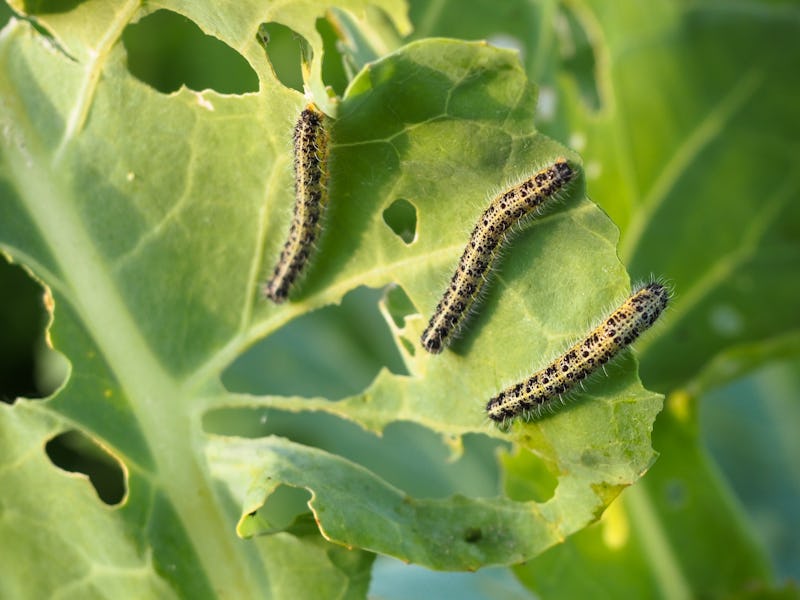Insect Bites Reveal the Origins of an Elusive Plant Behavior
Fossils reveal that plants have slept with their leaves folded for at least 250 million years.

Two-hundred-fifty million years ago, an insect got hungry for a midnight snack. It chewed through the wide leaf of a now-extinct gigantopterid plant, sowing rows of rounded punctures.
The holes were so prominent that they’re still visible in the fossilized leaf today. But it isn’t the size or shape of the insect bites that intrigues researchers. Rather, it’s how the bites are arranged — in two symmetrical rows on either side of the leaf’s center.
Such a pattern could only be made by a ravenous insect while the leaf was folded in half. The gigantopterid fossil along with other specimens reveal that some ancient plants closed their leaves at night just like many plants do today.
How plants developed circadian rhythms, including the unique behavior to fold up their leaves and flowers while sleeping, is poorly understood. But a new report in the journal Current Biology investigates how some early flora evolved the trait, thanks to the not-so-subtle snacking of elusive insects.
Holey snackerel
During a 2013 trip to Xishuangbanna Tropical Botanical Garden in Yunnan Province, China, paleobiologist Zhuo Feng observed a curious pattern of insect bites on the leaves of an Arachis duranensis plant. Symmetrical holes indicated that its leaves were folded in half while the insect ate.
Symmetrical damage on this clover shows that an insect made a meal of the plant while its leaves were folded shut during the night.
A. duranensis is a nyctinastic plant, meaning its leaves fold every night as the Sun sets. Feng, the lead author of the new study, tells Inverse that damage from hungry bugs is actually quite common in many species of nyctinastic plants when their leaves are folded.
And for Feng, who researches ancient ecosystems at Yunnan University in Kunming, the peculiar bite marks sparked questions about plants living millions of years ago.
“I wondered if it was possible to find similar insect damage in fossil leaves and to demonstrate the nyctinastic movements of fossil plants,” he says.
In the years after that visit, two holey gigantopterid leaf fossils were unearthed from the Xuanwei Formation in Southwest China. During the late Permian period approximately 250 million years ago, the region would have resembled a rainforest with dense, diverse vegetation.
One of the gigantopterid leaves dug up from the Xuanwei Formation, showing symmetrical damage on each side of the leaf.
Gigantopterids would have grown alongside ginkgos, ferns, and primitive cycads, Feng says. And with the plethora of plant growth, insects and other herbivores would have proliferated in an environment where they had plenty to eat.
Finding the culprit
For the new study, Feng and colleagues compared the two gigantopterid fossils to hundreds of living plant specimens to determine if the holes were made by insects – or perhaps something else.
While plant matter often becomes damaged during the fossilization process, the leaves did not show signs of this type of destruction.
“Insect-feeding damage can be easily distinguished from physical damage,” Feng says. “Morphologically, physical damage is commonly irregular, but insect-feeding damage is commonly regular in shape.”
In living plants, the area around a bite tends to thicken in response to insect attacks. It takes on a shape and texture that is extremely similar to the holes in the fossilized leaves.
But what about the bug who left behind those holes? Unfortunately, it’s tougher to track down the culprit since the fossils of insect bodies from the Paleozoic era (541 to 252 million years ago) are rarely dug up in Southwest China, Feng explains. That leaves a gap in what we know about insects from that time.
Gigantopterids were a diverse group of plants. These unchewed leaves belong to the species Gigantonoclea.
“We have no idea about the size or shape of the potential insects,” he says. Tentatively, the researchers think that ancient orthopteroids or coleopterans, respectively the ancestors of today’s crickets and beetles, may have been responsible for chewing round holes in the fossilized leaves.
Whichever critter did the damage certainly left its mark on science. The perforations indicate the earliest examples of foliar nyctinasty — folding of the leaves at night — discovered to date.
Searching for roots
Though the results of the study make it clear that plants have been sleeping with their leaves closed for hundreds of millions of years, there are still many questions unanswered about this unique behavior.
In today’s nyctinastic plants, leaf folding is controlled by a section at the base of each leaf called the pulvinus. But in the fossilized gigantopterids, the pulvinus was not preserved, making it unclear if the plants controlled their leaf motions the same way.
And while these nocturnal movements have fascinated many scientists — including the likes of Charles Darwin — it’s still unclear what evolutionary advantage nyctinasty gives to plants.
It could be thermoregulation, improved ability to shake off rainwater, or even an attempt to dissuade insects from eating leaves at night, as previous studies suggest. But none of the explanations are entirely satisfying, Feng says.
Still, it’s clear that nyctinasty was important for plants even in ancient times.
“Our study adds an extra piece of information to the puzzle showing that this behavior had benefits for plants as far back as the Permian,” Feng says.
This article was originally published on